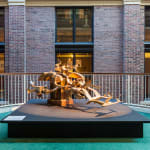Richard Hunt USA, b. 1935
111.8 x 139.7 x 223.5 cm
Further images
By the time Hunt graduated from SAIC in 1957, his work had already been exhibited by MoMA, a testament to his strikingly personal language of lyrical abstraction, mature beyond his years. Though he was comfortable working with a range of materials, including found objects, wood and steel, a fellowship that allowed him to travel through reconstructed Europe in 1958 convinced him that metal epitomized the spirit of the Modern World.
Following his landmark solo retrospective at MoMA in 1971, titled The Sculpture of Richard Hunt, the artist embarked on what he would eventually call his “second career” as a public artist. His public sculptures embodied Hunt’s interest in attaining “a synthesis of organic and industrial subject matter.” He never stopped making smaller scale works, however. In his smaller works we can plainly see the emergence of the visual language that informs his larger sculptures.
In an interview in Michigan Quarterly Review from 2018, Hunt described his process for creating these works. The author wrote:
“He says the forms he creates in part come about because of the realities of the materials, like bronze or steel. But they also in part come about because of the sense of beauty that he’s trying to express. He doesn’t see them as natural forms exactly, but he says “they express natural tendencies,” like a gesture, a movement, or a process. Their humanity has something to do with the physical way Hunt has of interacting with them while fashioning their every element with his own body. Hunt hits them with fire, slices into them, bends them, and pounds on them with a hammer atop an anvil until eventually their lines become graceful and soft. His dynamism becomes the dynamism in the work. Every flaw is nurtured until it becomes beautiful; each separate element is coaxed into becoming part of the unified whole.”













